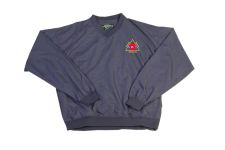
|

|
|
Online Edition: 045 September 2014 |
The Master's Edge 
Michael A. Sullenger
9th Dan AKS Chief Instructor . . . |
|
|||||||||||||||||||||||||||||||||||||||||||||||||||||||||||||||||||||||||||||||||||||||||||||||||||||||||||||||||||||||||||||||||||||||||||||||||

Dave Thomas
8th Dan . . . |
Traits of an AKS Black BeltIt has been my pleasure and privilege to meet and train with almost all of the American Karate System Black Belts. Many are veteran instructors and competitors who have brought honor and prestige to our organization. I believe they are as esteemed and talented a group of martial artists as one could find; regardless of style. There are many differences in that of our august body,(1) but I have often considered what are the common threads? A Black Belt is earned through sacrifice and hard-work; accompanied by pain and fatigue. Yet we persevere; maybe just to prove to ourselves we could do it. I see these as the common threads: Commitment - No one earns a Black Belt without being 100% committed to training the body and learning more about the martial arts. The training requires body and mind. One Black Belt told me that in addition to the six months of outside training before First Dan testing; at the same time they had gone through more personal introspection than they had in their whole life. Tenacity - A cornerstone of being a Dan rank; obstacles and interruptions are just another hurdle to be surmounted on the way. Black Belts are not quitters, training requires both physical and mental development to keep the end goal clear. As we tell our students - in the street there is no quitting. Loyalty - An ancient martial arts principle often lost in our modern culture. I am proud to see our Black Belts are loyal to the AKS, to their instructors, and to their students. Even Black Belts that have gone their own way still pay respect to the teacher that got them started on their martial arts career. Honor/Respect - These two ideals are united in that you cannot have one without the other. Regardless of the schools or the geography, the adherence to a code of honorable conduct and respect regardless of rank is a cornerstone of our style. Sometimes newcomers smile when I refer to a six-year-old as mister or miss. I remind them that the respect is mutual. Respect is one of the reasons our veteran Black Belts are adamant in their support of the AKS. In the beginning, we were told we were not real karate. When we were not accorded respect, we had to literally fight for it. Collectively, we did a great job. Today the AKS is recognized world-wide as one of the first true American Karate organizations, and our Black Belts are held in high regard. Intelligence - Many of our Black Belts come from higher education, college degrees, extensive post graduate training, even doctorates are replete in our ranks. Certainly it is not required, but it speaks to the type of personality that earns their AKS Black Belt. They are success driven and are accomplished in their chosen profession. I talked with one of our Black Belts who is currently in a service industry job. He said his peers often bemoan their occupation and demean it's significance. He said, "This is my job right now, and I am being the best at what I do." Humility - Humility, like loyalty, is one of the martial art tenets that gets lip service but is seldom practiced as it should be. I have never had an AKS Black Belt tell me how great a karateka he is, and all the tournaments he/she won, and on, and on. The best competitors I know don't trumpet their victories but help our students earn their own victories. Their skill and knowledge becomes evident when they put their uniform on and step onto the floor. They practice their convictions and let their actions speak for themselves. Compassion - This is the last element in an AKS Black Belt's arsenal of traits, and maybe the most important. Compassion for our art, compassion for our students, and compassion for the AKS. This is the thread that runs through all our clubs, the one we pass on to our students. We want them to continue the legacy of training and sharing knowledge when they become the teachers.
I am sure there are more values that could be added to this list. I think what is listed here is what we share in common, and what we strive to pass on to our future American Karate System Black Belts.
|
|||||||||||||||||||||||||||||||||||||||||||||||||||||||||||||||||||||||||||||||||||||||||||||||||||||||||||||||||||||||||||||||||||||||||||||||||
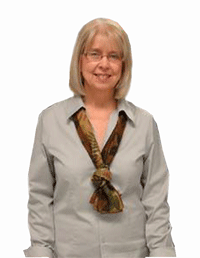
AKS Webmaster
. . . |
Remembering Ernie
Mr. Jamison Wymer posted this video in Facebook that I would like to share with you here. Bill Wallace reminds me so much of Ernie Lieb in his enthusiasm, energy, and pure enjoyment of karate! Watch and enjoy!
. . . . a blast from the past . . . 
This is an early picture of Mr. Lieb during competition at an Ed Sell tournament in Detroit Michigan in 1967. Mr. Lieb (on the right) was fighting a tough midwest opponent named Robert Moore. The referee on the left was Jim McClain. The center referee (wearing gray) was Mr. Kennedy. Both were black belts in the United States Karate Association (USKA).
Do You Have a Question ?We invite you to send in your questions regarding karate and the A.K.S. so that we may respond here in our newsletter. If you have a concern, question or suggestion, please let us know and we will address it here in the Punchline. If you don't want your name published, please let us know and we will be happy to withhold that information from print. However, please be respectful when submitting your queries or suggestions to us by including your name so that we may understand your questions and/or circumstances. We look forward to hearing from you !
|
|||||||||||||||||||||||||||||||||||||||||||||||||||||||||||||||||||||||||||||||||||||||||||||||||||||||||||||||||||||||||||||||||||||||||||||||||
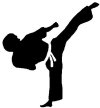
. . . |
PROMOTIONS!!
|
Congratulations to all students who have been promoted this past quarter, and to those we've missed in prior newsletters. Best wishes in your continued training! Attention Instructors, if you have students who have been promoted, please send this information so that we may acknowledge their accomplishments.
|

Ernest H. Lieb
10th Dan AKS . . .
|
[ Note: I have chosen to use this space as further emphasis to the origins of our style. This article is from the September, 2005 issue of the Punchline and was written by Ernie Lieb. ] More A.K.S. History
Dear A.K.S. members and friends.
So there you have a bit more of American history on how Karate began in our nation. We thank those who have contributed articles to our newsletter. We encourage anyone who would like to contribute to this "quarterly" space to submit your article to: werner.lj@gmail.com
|

. . .
|
| ||||||||||||||||||||||||||||||||||||||||||||||||||||||||||||||||||||||||||||||||||||||||||||||||||||||||||||||||||||||||||||||||||||||||||||

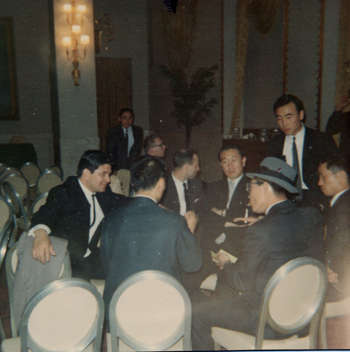 The first picture, clockwise, is of Cihak H. Cho (gentleman with hat), Jhoon Rhee, Ed Parker, Ernie Lieb, Khee Wang Kim and others. It was the beginning of the Koreans in America breaking away from their own S. Korean Tae Kwan Do organization. The following day, they established their own International Tae Kwan Do association. Mr. Ed Sell and I attended that meeting. We both declined to be a part of it. The following year, I put the word "American" in front of everything I did. But I never broke ties with my teacher, Mr. Kim, of South Korea. I faced many difficult and frustrating years when I competed if these Korean instructors where judging or refereeing my fights. Several times, I even challenged them to fight me in the square. They where not stupid and never did. My loyalty became known to Chong Woo Lee himself, later head of the Tae Kwan Do association in Korea. I remember receiving a very kind letter from him for keeping my honor and that of my teacher. Later on, both organizations made peace with each other. I am glad for the sake of Tae Kwon Do.
The first picture, clockwise, is of Cihak H. Cho (gentleman with hat), Jhoon Rhee, Ed Parker, Ernie Lieb, Khee Wang Kim and others. It was the beginning of the Koreans in America breaking away from their own S. Korean Tae Kwan Do organization. The following day, they established their own International Tae Kwan Do association. Mr. Ed Sell and I attended that meeting. We both declined to be a part of it. The following year, I put the word "American" in front of everything I did. But I never broke ties with my teacher, Mr. Kim, of South Korea. I faced many difficult and frustrating years when I competed if these Korean instructors where judging or refereeing my fights. Several times, I even challenged them to fight me in the square. They where not stupid and never did. My loyalty became known to Chong Woo Lee himself, later head of the Tae Kwan Do association in Korea. I remember receiving a very kind letter from him for keeping my honor and that of my teacher. Later on, both organizations made peace with each other. I am glad for the sake of Tae Kwon Do.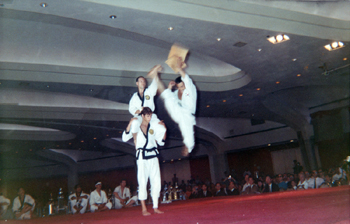 The second picture is of me sitting on top of a very tall American fighter, named Bob Yarborough. Mr. Julio La Salle is breaking the boards with a high jump kick. He is the fighter that was rated the East Coast Light Weight Champion out of New York. He was a student of Cihak H. Cho, also a Ji Do Kwan ["Chi Do Kwan"] instructor. I beat Mr. La Salle in Boston the previous year. He was glad he said another guy from the same style won. Just not glad he lost to an unknown, which is what I was until 1967. But he was a heck of a sportsman and bought my dinner that evening. Mr. Cho was not as happy, but he was polite.
The second picture is of me sitting on top of a very tall American fighter, named Bob Yarborough. Mr. Julio La Salle is breaking the boards with a high jump kick. He is the fighter that was rated the East Coast Light Weight Champion out of New York. He was a student of Cihak H. Cho, also a Ji Do Kwan ["Chi Do Kwan"] instructor. I beat Mr. La Salle in Boston the previous year. He was glad he said another guy from the same style won. Just not glad he lost to an unknown, which is what I was until 1967. But he was a heck of a sportsman and bought my dinner that evening. Mr. Cho was not as happy, but he was polite.


